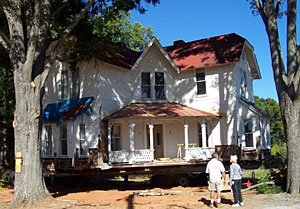The solution to disinvestment is not demolition, but investment

Jesse Baltimore house, a Fullerton model of a Sears kit house, is on the right. A picture of the Fullerton model is on the left. Image by Peter Sefton.
Today's Post reports that the Jesse Baltimore house is going to be demolished. The City government posted an unreasonably short period of time for proposals to move the building and now they are going to tear it down. (Also see "Priced to Move: If You Can Transport It to a New Site, You Can Have a Historic Palisades House That Has Seen, Well, a Catalogue of Woes .")
Today's Preservation Online reports that Lowe's, the building products retailer, is moving a house from their campus. Working with the statewide preservation organization, they spent the time necessary to come up with a plan to move the building. See "Lowe's Pays to Move 1885 House off its Campus."

With $260,000 from Lowe's, including house materials, new owner Kay Kirby will restore the Mott House as a showcase for her design business. The Sept. 29 move cost $150,000, according to Stout. Lowe's contributed $260,000 to the project, including house materials, and donated $10,000 to Preservation North Carolina. (Image: Preservation North Carolina)
Like Lowe's, perhaps DC Government should have paid for the house to be moved, rather than expecting others to pay.
The real solution, as Mary Rowse wrote in an op-ed published in the Post, "Let's Save This House," was to keep the building in place, and sell it to someone who wanted to live there--adding property and income tax revenue to the city, and a potentially active and engaged family to join the neighborhood, and converting a vacant building into an occupied property. Does the Palisades park really need more green space for an entrance?
People's concerns about the building were really more about the DC Government's derelict management of the property over the years. Addressing that failure was the real issue. The house, and the DC tax rolls, are the victims here.
This is a failure of vision.
Also see the past blog entry "Bringing buildings back is really bringing urban neighborhoods back."

Labels: asset-based community development, historic preservation, parks, urban design/placemaking, urban revitalization



0 Comments:
Post a Comment
<< Home